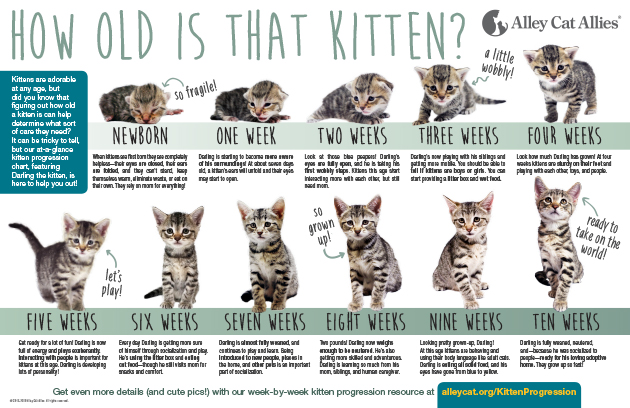How to Tell How Old a Kitten is: Quick Age Guide

To determine the age of a kitten, examine its physical characteristics, such as the teeth and eyes. Kittens are typically born with closed eyes, which open around 7-10 days old.
At 2-3 weeks, their baby teeth start to come in, and by 6-8 weeks, all 26 baby teeth should be present. The presence of permanent teeth at around 3-4 months indicates a kitten is entering the adolescent stage. Additionally, the size and weight of a kitten can provide clues about its age, as they grow rapidly during the first few months.
By considering these factors, you can accurately estimate the age of a kitten.

Credit: www.alleycat.org
Starting Points In Kitten Age Identification
To determine a kitten’s age, examine teeth development, weight, and behavior cues. Newborn kittens have closed eyes, while six-week-olds have adult-like teeth. Weighing around 1 pound indicates a 4-week-old kitten. Understanding these starting points can help accurately identify a kitten’s age.
Starting Points in Kitten Age Identification: As a pet owner, it’s important to know how to tell how old a kitten is to provide the right care and nourishment at every stage of their growth. While it may seem difficult to tell a kitten’s age, there are some starting points that can give you an idea of their age range. Here are two main starting points in kitten age identification:
Physical Features And Milestones
Physical features and milestones can be helpful in determining a kitten’s age range. Here are some things to look out for:
- Birth to 2 weeks: Kittens are born with their eyes closed and ears folded. They rely on their sense of smell and touch to locate their mother and feed. They typically double their weight within the first week.
- 2 to 4 weeks: Kittens’ eyes start to open and they begin to see and hear. They start to crawl and develop their sense of balance. They also start to teeth and their ears will start to unfold.
- 4 to 8 weeks: Kittens become more active and start to play with their littermates. They start to eat solid food and wean off their mother’s milk. Their teeth continue to grow and they start to lose their baby teeth.
- 8 to 12 weeks: Kittens are fully weaned and are ready to be separated from their mother. They start to develop their adult teeth and their adult coat starts to come in. They also become more independent and start to explore their surroundings.
Behavioral Clues
Behavioral clues can also be helpful in determining a kitten’s age range. Here are some things to look out for:
- Birth to 2 weeks: Kittens spend most of their time sleeping and eating. They don’t have much mobility and rely on their mother for warmth and protection.
- 2 to 4 weeks: Kittens start to become more active and will start to play with their littermates. They start to develop their personalities and will start to purr and knead.
- 4 to 8 weeks: Kittens become more adventurous and will start to explore their surroundings. They become more confident and will start to interact more with humans.
- 8 to 12 weeks: Kittens become more independent and will start to assert their dominance. They become more playful and will start to chase and pounce on toys.
By using these two starting points in kitten age identification, you can get a general idea of your kitten’s age range. However, it’s important to remember that every kitten develops at their own pace and these starting points are just guidelines. If you’re still unsure of your kitten’s age, it’s best to consult with a veterinarian for a more accurate assessment.
Birth To Two Weeks: Neonatal Period
During the neonatal period, which lasts from birth to two weeks, kittens are at their most vulnerable stage of development.
Closed Eyes And Ears
Newborn kittens are born with closed eyes and ears, as these senses are not yet fully developed.
Limited Mobility
Kittens have limited mobility during this period, relying on crawling to move around.
Dependency On Mother
Newborn kittens depend entirely on their mother for warmth, food, and care.
Two To Four Weeks: Transitional Stage
During the two to four-week mark, kittens enter a transitional stage where they start to develop both physically and behaviorally. This is an exciting time as they begin to open their eyes, explore their surroundings, and even grow their first set of baby teeth. Let’s take a closer look at the key milestones during this stage:
Opening Eyes
At around two weeks old, kittens start to open their eyes for the first time, providing a glimpse into their rapidly changing world. Initially, their eyes may appear cloudy or bluish, but they will soon take on their natural color. It’s important to note that not all kittens open their eyes at the exact same time, so don’t worry if one kitten’s eyes open before another’s.
Beginning To Explore
As their vision improves, kittens become more curious and adventurous during this transitional stage. They start to venture out of their nesting area, wobbly at first, but gradually gaining confidence in their movements. Exploring their surroundings helps them develop their coordination and motor skills, preparing them for future independence.
First Baby Teeth
Between two and four weeks old, kittens start to develop their first set of baby teeth. These tiny, needle-like teeth are sharp and aid in the transition from a milk-only diet to consuming solid food. You may notice them nibbling on soft food or even trying to chew on objects. It’s essential to provide appropriate chew toys to satisfy their natural urge to chew and prevent them from damaging valuable items.
By understanding the milestones that occur during the two to four-week transitional stage, you can ensure that you are providing the necessary care and support for your growing kittens. From their opening eyes to their first baby teeth, each development brings them closer to becoming independent and playful feline companions.
Four To Eight Weeks: Socialization Period
During the Four to Eight Weeks socialization period, you can determine a kitten’s age by observing their behavior. Kittens at this stage are curious, playful, and starting to explore their surroundings. They are also learning important social skills from their mother and siblings.
During the four to eight-week socialization period, kittens start to become more active and playful. They will begin to learn important life skills such as play behavior, weaning process, and litter box habits. It is crucial to provide a safe and stimulating environment for your kitten during this period. In this section, we will discuss these three aspects of a kitten’s life in detail.
Play Behavior
Kittens at this age are full of energy and love to play. They will start to explore their surroundings and interact with their littermates. Playtime is an essential part of their development, and it helps them to develop coordination, agility, and social skills. You can encourage playtime by providing your kitten with toys such as balls, strings, and stuffed animals. It is also essential to supervise playtime to ensure that your kitten does not hurt themselves.
Weaning Process
During the four to eight-week period, kittens start to wean from their mother’s milk and transition to solid food. You can introduce your kitten to solid food by offering a small amount of wet food mixed with water. As your kitten becomes more comfortable with solid food, you can gradually increase the amount and decrease the frequency of milk feedings. It is crucial to monitor your kitten’s weight and ensure that they are gaining weight consistently.
Learning Litter Box Habits
Kittens at this age will start to learn litter box habits. It is important to provide your kitten with a clean and accessible litter box. You can encourage your kitten to use the litter box by placing them in it after meals and playtime. It is also important to clean the litter box regularly to ensure that your kitten has a clean and hygienic environment.
In conclusion, the four to eight-week socialization period is a crucial time for a kitten’s development. By providing a safe and stimulating environment, you can help your kitten to learn important life skills such as play behavior, weaning process, and litter box habits. Remember to supervise playtime, monitor your kitten’s weight, and provide a clean and accessible litter box. With the right care and attention, your kitten will grow into a healthy and happy adult cat.
Eight Weeks To Six Months: Juvenile Stage
Rapid Growth
Kittens experience rapid growth during the juvenile stage, typically doubling or even tripling their weight within the first few weeks. This period is marked by a significant increase in size and development.
Full Set Of Teeth
By the time a kitten reaches the age of six months, it will have a full set of 30 adult teeth. This marks the completion of their dental development, and they will need proper dental care to maintain their oral health.
Vaccination Schedule
During the juvenile stage, kittens require a series of vaccinations to protect them from common feline diseases. The vaccination schedule typically includes immunizations for diseases such as feline leukemia, rabies, and distemper.
Determining Age By Weight
Evaluating a kitten’s age by weight is a practical approach. A kitten’s weight can offer valuable insights into its age, with a general guideline of around 1 pound per month of age. By carefully weighing the kitten and comparing it to the average weight for its age, you can estimate its approximate age.
Average Weights By Week
Determining the age of a kitten can be a challenging task, but one method that can provide valuable clues is by assessing their weight. Kittens go through rapid growth during their early weeks, and their weight can give us an idea of how old they might be. Here are some average weights by week that can help you estimate the age of a kitten based on their weight:
| Week | Average Weight |
|---|---|
| 1 | 3-7 ounces |
| 2 | 7-14 ounces |
| 3 | 10-20 ounces |
| 4 | 12-24 ounces |
| 5 | 14-28 ounces |
Please note that these weights are approximate and can vary depending on the breed and health of the kitten. It’s important to consider these factors when estimating the age based on weight alone.
Factoring In Breed And Health
While the average weights by week can give you a general idea of a kitten’s age, it’s crucial to take into account the breed and overall health of the kitten. Different breeds have different growth rates, so a Maine Coon kitten might weigh more than a Siamese kitten of the same age.
Additionally, a kitten’s health can also affect their weight. If a kitten is underweight or malnourished, they may not follow the typical weight patterns. To determine the age accurately, it’s best to consult a veterinarian who can consider various factors like teeth development, coat condition, and overall physical appearance. They will have the expertise to provide a more precise estimate of a kitten’s age.
Remember, estimating a kitten’s age based on weight alone is not an exact science. It’s always a good idea to seek professional advice to ensure the best care for the little furball in question.
Key Developmental Milestones
Key Developmental Milestones in a kitten’s growth can help determine their age. Understanding these milestones such as Motor Skills, Sensory Development, and Social Skills can give you valuable insights.
Motor Skills
- Kittens start crawling at around two weeks old.
- They can walk steadily by three weeks.
- By four weeks, kittens can run and play.
Sensory Development
- Eyes open at around 7 to 10 days old.
- Hearing develops by two weeks.
- Sense of smell is fully developed by three weeks.
Social Skills
- Kittens start interacting with their littermates at two weeks old.
- Playing with toys begins at four weeks.
- Litter training typically starts at around three weeks.

Credit: www.reddit.com
Common Misconceptions About Kitten Age
Common misconceptions about determining a kitten’s age can lead to inaccurate assessments. Understanding the key indicators like size, fur color changes, and playfulness can help in correctly estimating a kitten’s age.
Size As An Age Indicator
Weight and size are not always reliable indicators of a kitten’s age.
Fur Color Changes
Kitten’s fur color can change as they age, so relying solely on this factor can be misleading.
Misjudging Based On Playfulness
Playfulness does not always correlate with a kitten’s age; some kittens are more energetic regardless of age.
When To Consult A Professional
Consult a vet if unsure about kitten’s age.
Uncertain Signs
If unsure, consult a vet for guidance.
Health Concerns
Professional advice needed for health concerns.
Adoption Considerations
Vet consultation essential before adoption.
Frequently Asked Questions
How Can You Estimate A Kitten’s Age?
To estimate a kitten’s age, observe its physical characteristics such as teeth, eyes, and behavior. The teeth and eye color can provide clues, and a vet can also help with a more accurate assessment.
What Is The Age Range For A Kitten?
Kittens are typically considered to be between the ages of 0-6 months. They go through different developmental stages during this time, from being completely dependent on their mother to becoming more independent.
What Are The Key Developmental Milestones For Kittens?
Kittens reach various milestones as they grow, including opening their eyes at around 7-10 days, starting to walk and play at 3 weeks, and being weaned at 6-7 weeks. These milestones can provide insight into their age.
At What Age Can Kittens Be Adopted?
Kittens are usually ready for adoption at around 8 weeks of age. At this point, they are typically weaned, litter-trained, and have developed the necessary social skills from their mother and littermates.
Conclusion
Accurately determining a kitten’s age is crucial for proper care. By observing physical and behavioral cues, you can estimate a kitten’s age and provide appropriate care. This knowledge ensures that the kitten receives the necessary nutrition, medical attention, and socialization to thrive in its new environment.





